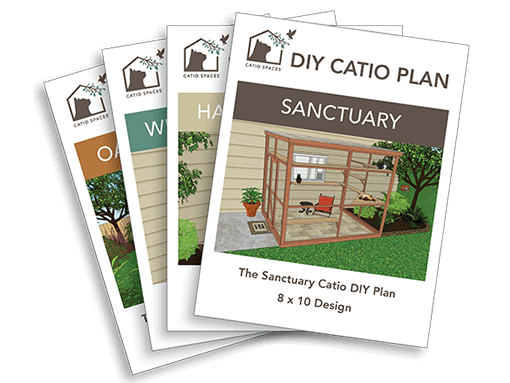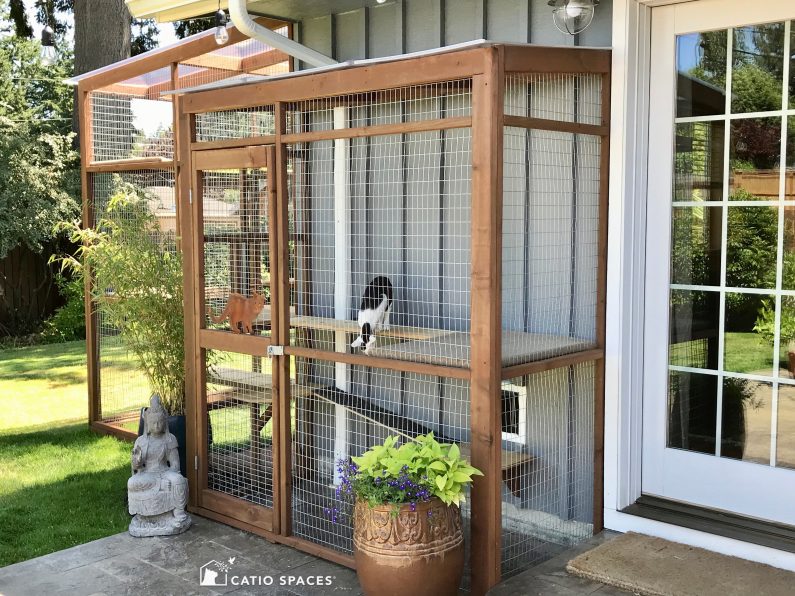
It’s natural for cats to want to enjoy the fresh air, sights, sounds, and stimulation of the outdoors. A catio — an outdoor cat enclosure or “cat patio” – is a solution that provides your cat the enrichment of the natural world without the dangers that come with a free-roaming life. A catio also provides peace of mind knowing your cat is always safe while protecting birds and wildlife.
When you build a catio, you want it to last and provide freedom from stress and worry. That means starting with a tried-and-true DIY Catio Plan and making some sensible up-front decisions that will ensure your new catio is a secure, attractive haven that you and your cat will enjoy.
Let’s start your building project on the right paw. As a catio builder and founder of Catio Spaces, here are some helpful tips to avoid these 8 common catio-building mistakes.
1. A level foundation is key for a successful project.
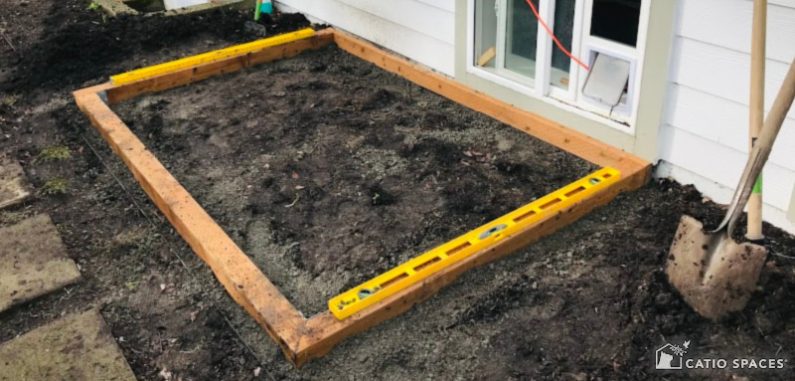
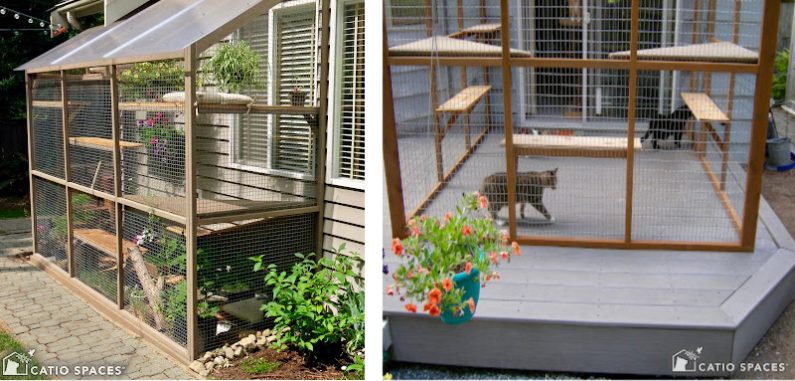
It’s important to build your catio on a flat, level surface. If your catio will be located in your garden or a grassy yard, take time to level the building site. Remember, tree roots grow and buried stones heave with the frost. Over the seasons, they can start to lift part of your catio, creating gaps and stress on the square joints of your structure. Check for and remove these hazards in advance.
Be sure to call 811 before you dig to identify underground utilities for a safe and successful project.
If you’re building on a deck or patio that needs some repair or is due to be stained or water-treated, complete these tasks before beginning your catio project. A concrete patio will likely slope away from the house so use shims to keep the catio level.
2. Ensure your catio is dig and escape-proof.
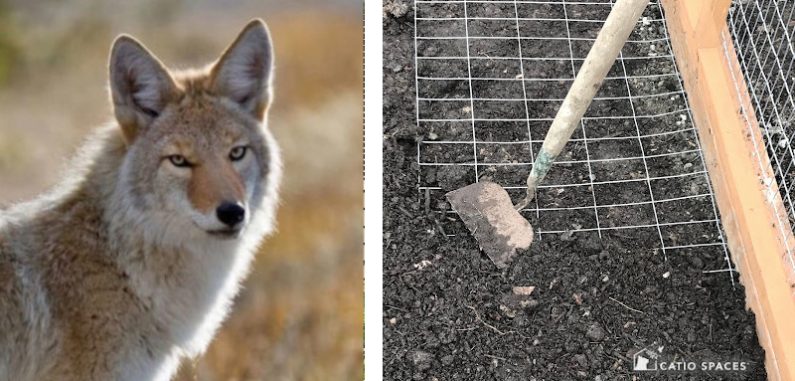
Coyotes and other wildlife can quickly dig under a catio ground frame if they are curious about what they might find on the other side. They can then slip in…or your cat could slip out. Your own dog might be curious as to why they can’t reach their feline friend and may enthusiastically try to dig a hole to join them. Make sure your catio is secure from the foundation to the roof.
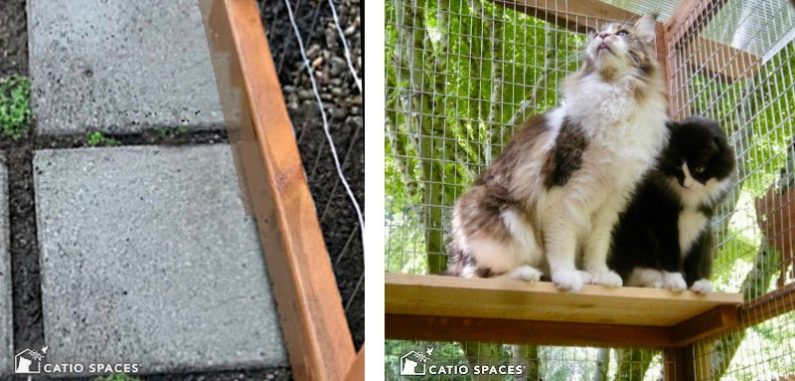
Here are some dig-proof tips:
- Add catio wire outside your catio ground frame at a 90-degree angle, stapling the frame and burying it beneath the ground or sod. This will discourage both wild and domestic diggers.
- You can also purchase a commercial digging barrier that extends the wall of your catio below ground, but a determined digger might be able to excavate beneath it.
- Add decorative, concrete pavers around the perimeter or inside your catio as a dig-proof option.
- Check your catio from the ground to the ceiling to insure your cat is protected.
If you build your catio on a deck or concrete patio, you already have a dig-proof foundation to keep wildlife and predators away.
3. No fake grass! Give your cat the real thing.
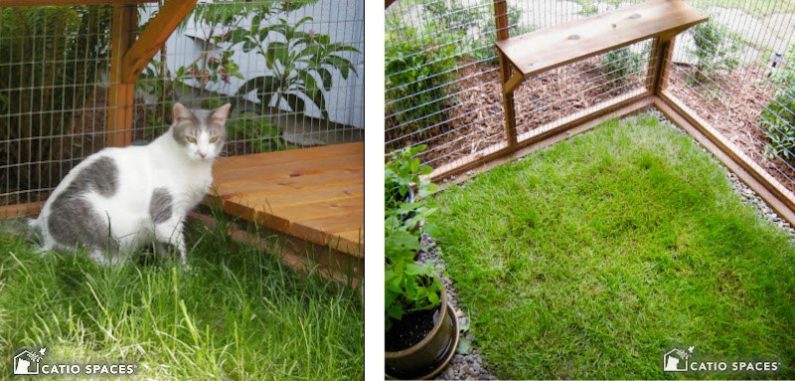
Your cat will enjoy natural grass so much more than stiff artificial turf. Although grass-like carpeting and turf made of plastic can look good year-round, there are drawbacks that go beyond appearances:
- The edges can fray, drawing the attention of a curious nibbling cat and creating a choking hazard.
- Without proper installation and drainage, the underside can create a damp environment for insects and mold.
- Faux grass robs your cat of the sensory experience of walking and laying in natural grass, so give them the real thing. Imagine wearing rubber sole tennis shoes at the beach instead of wiggling your bare toes in the sand!
- Natural grass can be easy to “mow” using a weed wacker or trimmer.
- If you have a polycarbonate roof, occasionally water the grass to keep it green. For wire mesh roofs, rainwater will keep it healthy.
Catios located on a deck or concrete patio can still offer a grass experience by adding a planter box or pot with grass for your cat to enjoy.
4. Choose a safe, strong, and long-lasting wire.
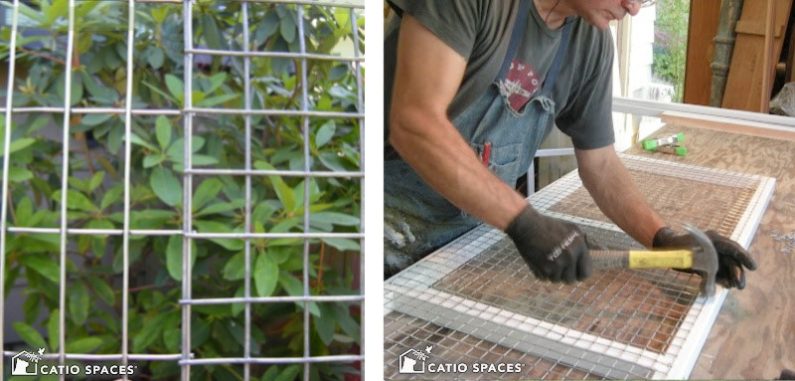
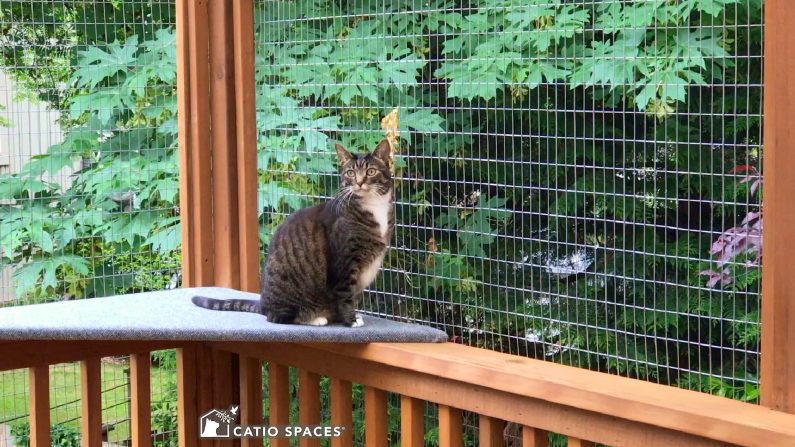
All wire is not created equal when it comes to creating a safe, secure catio that will keep your cat in, other creatures out, and that will last for decades.
- I recommend galvanized (rust-free) welded fencing wire in a sturdy but pliable 14-16-gauge thickness. The maximum grid size should be 2” wide x 4” high with the 2” width being smaller than the wingspan of most birds. Smaller grids of 1’x1” and 1”x2” are available and require more cutting time. Galvanized “hardware cloth wire” (1/2”x1/2”) is another option, although it is more costly and limits your cat’s view of the outdoors. Cut the wire to the gird line and use wood trim to cover any sharp ends for cat safety.
- Vinyl coated wire is attractive to look at, but it can deteriorate and crack over time due to UV exposure, creating a choking hazard for your cat. Sometimes the vinyl is also disguising fragile wire.
- Chicken wire is cheaper for a reason, so avoid the temptation to save a dime now and lose dollars later. It bends and stretches easily and typically won’t last anywhere near the life of a well-built catio. If you’re in bear country, a curious bruin can put quite a dent (or a tear) in taut chicken wire. And let’s face it: chicken wire also gives the impression of a cage rather than providing an attractive catio space.
5. Don’t block the sun from entering your catio.
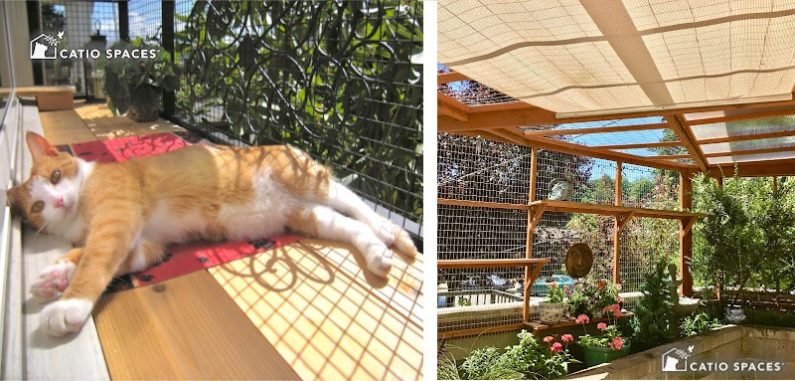
Cats are sun-loving creatures. Your cat already spends plenty of hours inside your home, most likely sitting on a sunny window sill pining for the outdoors, so I don’t recommend blocking access to sunshine with a light-blocking opaque catio roof. One of the most enjoyable catio experiences for your cat is basking in the warmth and light of the sun. But, of course, cats need the option of choosing shady spots too, especially on hot summer days. You can create this with a shade cloth, awning, or a sheltering bench.
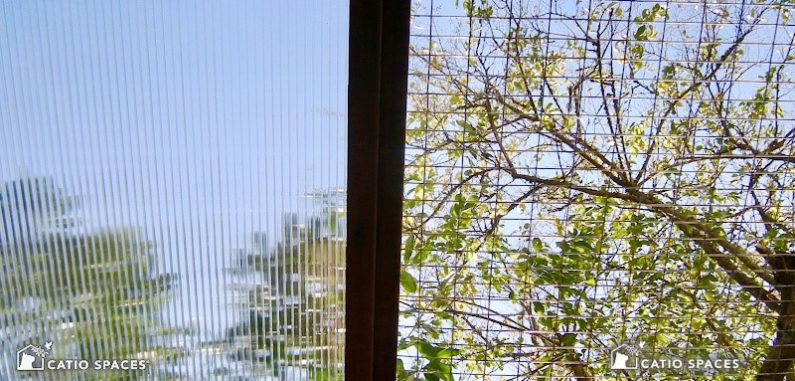
Transparent polycarbonate roof panels or a wire grid ceiling will let in the sunlight that your cat craves. Both provide a more natural way to enjoy the great outdoors.
6. Don’t leave food in your catio.
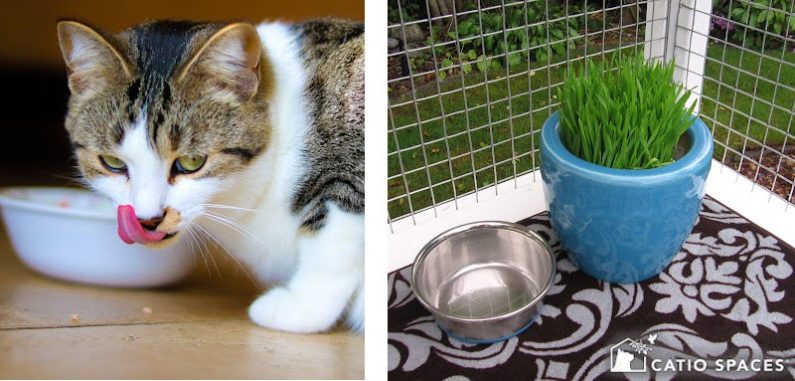
It can be tempting to feed your cat outdoors, especially if it’s a convenient way to keep their bowl away from the family dog. However, the intriguing scent of food can attract critters and wildlife. Wild animals are wise to the ways of humans and are used to checking around residences for unattended morsels. Limit catio nibbles to treats your cat will eat in your presence and add a water dish to keep your cat hydrated.
7. Don’t carry your cat to and from your catio in your arms.
Even the most laid-back cat can be startled by a backfiring car, a neighbor’s dog, or something as simple as snagging a toenail in your sweater. If your cat doesn’t have a cat door to come and go independently, they also lose the option to choose whether they want to be indoors or outdoors. Carrying your cat creates an additional escape risk and adds extra effort for you as you shuttle your cat back and forth. A cat door is a purrfect solution to keep your cat safe.
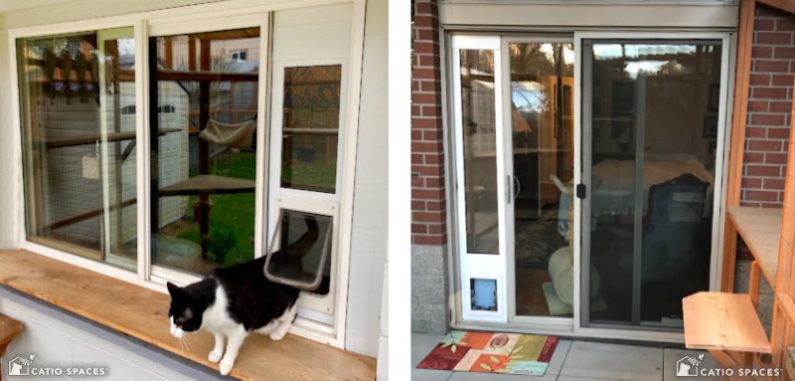
Your cat’s entry into a catio isn’t limited to a traditional “hole in a door” cat flap. You’ll be amazed at how many cat door options are available for window pass-throughs and sliding doors. Learn more on how to choose a catio door for your home and catio.
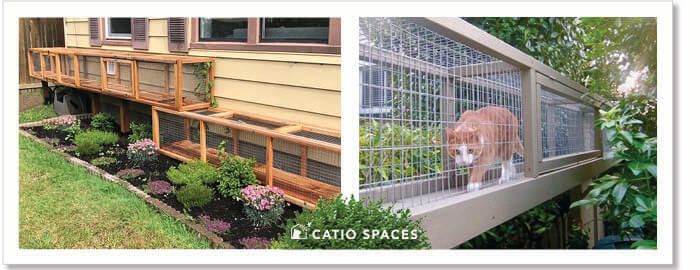
If the perfect spot for your dream catio isn’t right up against your home through a cat door, a Cat Tunnel can lead your cat to the catio. Whether a garden-level passageway or an overhead bridge, a cat tunnel can lead your cat on an adventure to a large, four-sided enclosure like the Oasis catio.
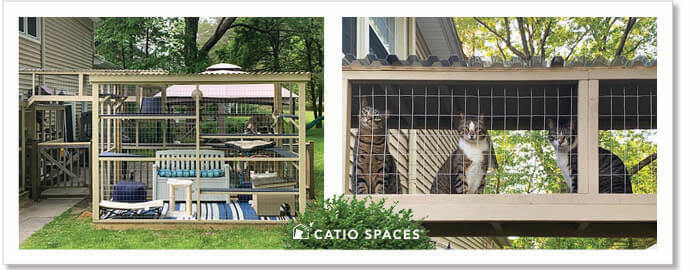
8. Don’t leave yourself out of the catio experience.
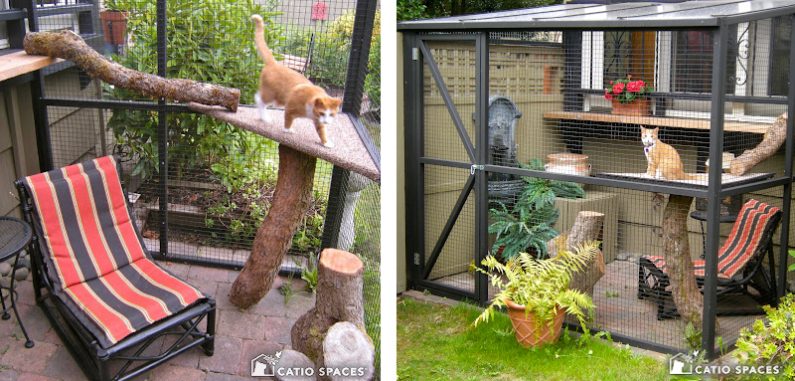
While a compact Window Box or Cat Tunnel catio is a purrfectly wonderful window of the world for your cat, why not take advantage of your catio-building project to create an outdoor space that’s large enough for you too? The Haven, Sanctuary and Oasis catios each come in various sizes, so you can pick a footprint that ranges from small to super-spacious.
A comfortable chair provides a special spot where you and your cat can enjoy some lap time and a good book – or even an outdoor movie. If you love beautifying garden spaces, a catio will give you outdoor room to work your decorating magic (we have some design tips, too.) Plus, you can paint or stain your catio to complement your home and garden.
Choose your DIY Catio Plan and start your catio-building journey.
With these valuable building tips and one of our award-winning DIY Catio Plans, you and your cat can reap all of the benefits of a well-built catio for years to come. Your cat will thank you for it!
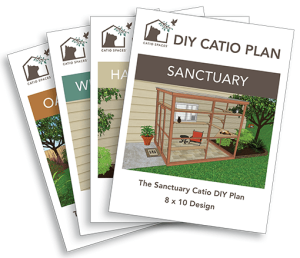
DIY Catio Plans are easy to build and include a list of tools and materials, step-by-step instructions, and diagrams for a successful project.
Catio Spaces donates 10% of purchases through our affiliate program to animal welfare organizations.
Plans are a PDF download so you can get started right away. Happy building!
LEARN MORE about how to build a DIY CATIO Plan for your cat >>

 Cynthia Chomos is a
Cynthia Chomos is a 
